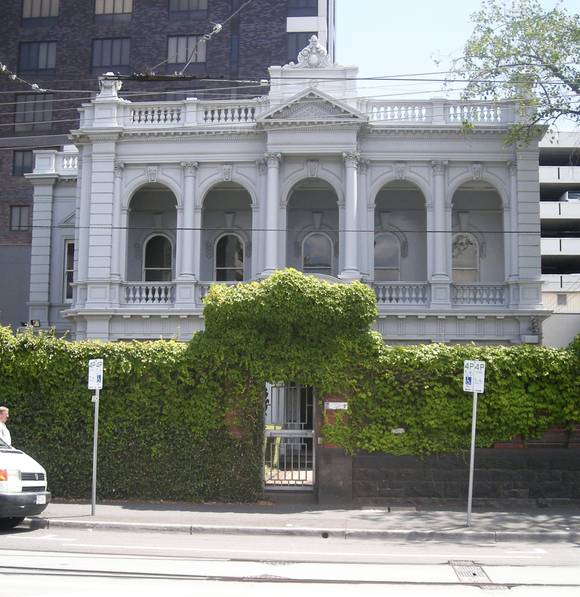| Back to search results » | Back to search page » |
|
DODGSHUN HOUSE
Other NamesFORMER EDENSOR , MARY MACKILLOP BIRTHPLACE , NURSES HOME EYE AND EAR HOSPITAL , FITZROY CITY NURSES HOME, EYE AND EAR HOSPITAL Location9 BRUNSWICK STREET FITZROY, YARRA CITY
File Numberpl-he/03/0090LevelRegistered |
|
Statement of Significance
What is significant?
Dodgshun House (formerly Edensor) stands on land first acquired by Sydney merchant Thomas Walker as part of a 25-acre allotment in May 1839. Jane Minton, who purchased part of the Lot in 1840 and is believed to have constructed the first building on the site, sold part of her 1/2 acre to Alexander Mackillop, father of Mary Mackillop, in October 1840. The land bought by Mackillop contained a dwelling known as Marino Cottage. Mackillop experienced financial difficulties and sold the land to stockbroker Johnathon Binns Were in 1842. Were sold the land the following year to John H. H. Spencer and eventually the site was acquired c. 1864 by lawyer and politician, Samuel Gillott. At the time of Gillott's purchase the site contained a cottage known as Como. Gillott built a house called Edensor c. 1865 and in 1899 demolished Como to allow for a southern extension. The property was sold to the Victorian Eye and Ear Hospital in 1927 and became known as Dodgshun House from that time on. Gillott enlarged a 3 room brick dwelling on the site to nine rooms c.1865 and extended again in 1899 to create a 13 room residence. The rendered Italianate facade is believed to have been added in the mid 1870s and in 1899 the side wing and rear extension were added by architects Hyndman and Bates. The two storey villa has a symmetrically arranged facade and an arcaded verandah on the upper verandah and lower porch. Balustrading is present on the first floor level and the central doorway is crowned by an entablature. The high brick wall, which runs the length of the Brunswick Street frontage and along the southern boundary fronting the laneway, was constructed during Gillott's occupation and now incorporates a 20th century gatehouse.
How is it significant?
Dodgshun House (formerly Edensor) and its surrounding land is of historical, social and architectural importance to the State of Victoria.
Why is it Significant?
The site on which Dodgshun House (formerly Edensor) now stands is of great historical and social significance as the birth place of Mary Mackillop. Mary Mackillop, later pronounced Blessed Mary Mackillop, was born at 9 Brunswick Street, Fitzroy, in 1842 to Alexander and Flora (nee MacDonald) Mackillop, Scottish Catholic emigrants. Mary, the first of eight children, was born at Marino Cottage and lived there with her parents until Alexander Mackillop's plunging fortunes necessitated the sale of the cottage and land to Jonathan Binns Were, the founder of J B Were and Son. In 1866, at the age of 24, Mary Mackillop established the first Josephite school in Penola and by the time of her death in 1909 at the age of 67 had instituted a 650 strong order, teaching over 12,000 children throughout Australia. The beatification of Mary Mackillop occurred in 1995 when Pope John Paul II pronounced her to be "Blessed", the final stage before sainthood. While Marino Cottage has long since disappeared, possibly incorporated into the fabric of Dodgshun House, 9 Brunswick Street Fitzroy has become historically and socially significant as a site of great religious pilgrimage.
Dodgshun House (formerly Edensor) is of historical importance for its association with Samuel Gillott, a prominent lawyer and politician who was elected Mayor in 1900, holding office for two terms. In 1901, the year of Federation, Gillott was knighted by the visiting Duke and Duchess of Cornwall and York and his office distinguished by the title Lord Mayor. Gillott made 9 Brunswick Street his home c.1864, building Edensor to provide "all the convenience of a town residence combined with the quiet of a country house". The house, with its fence and gatehouse, is of significance as one of the few large residences surviving in the area.
Dodgshun House (formerly Edensor) is of architectural significance for its side elevation which is a fine example of late Classicism with a distinctively-composed series of bays. The house is a representative example of townhouse composition and is finely decorated. The house's significance is accentuated by the fact that the front fence is original and parts of the garden survive.
Group
Religion
Category
Other - Religion








